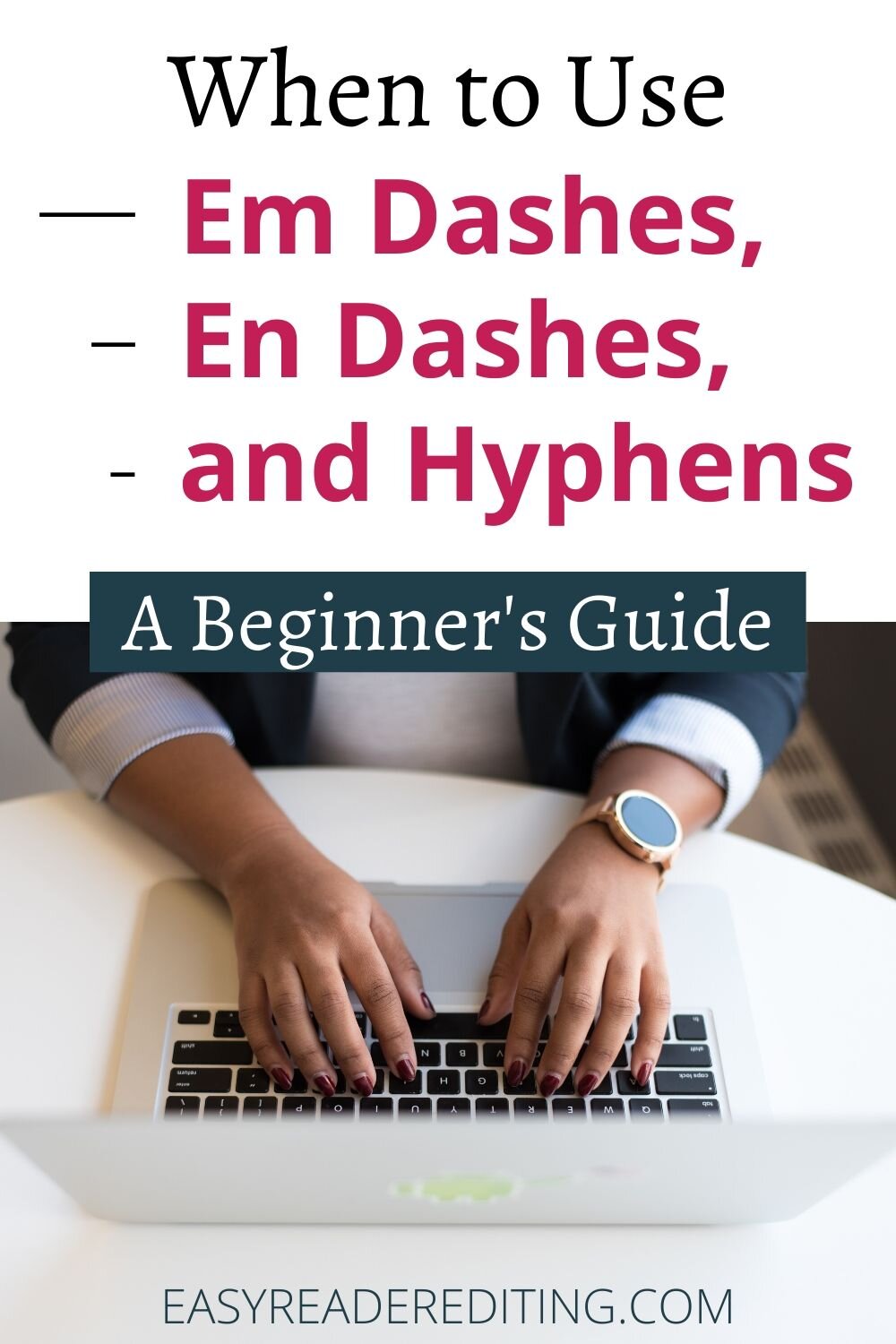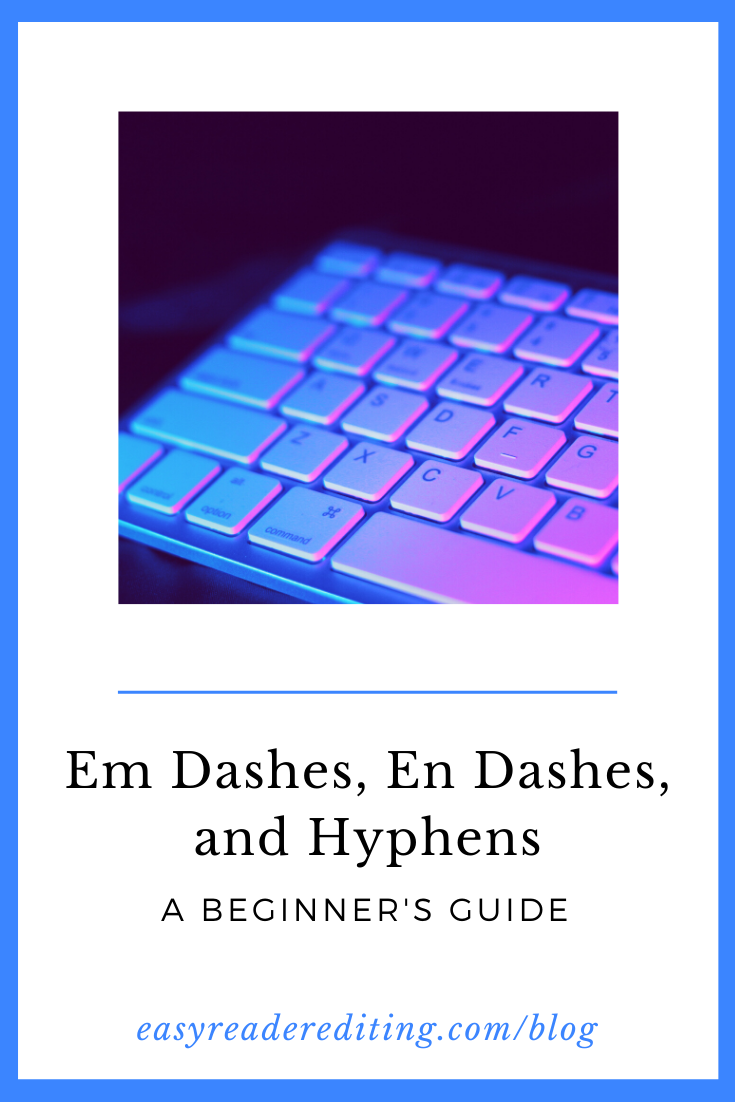A Beginner’s Guide to Em Dashes, En Dashes, and Hyphens
What’s the difference and how should I use them?
Image credit: Tom Swinnen via Pexels
Before I became a copyeditor, I never gave much thought to dashes, whether on my keyboard or on a printed page. I knew that sometimes the longer ones looked better for certain jobs, but it never occurred to me that each type of dash was a particular length and served a particular purpose.
Now older and wiser, I recognize that each type of dash signifies what’s going on around it. Many writers seem to get them confused, however, or—worse yet—use a hyphen for any dash required. Not only is it just plain wrong, it’s also a huge distraction when you’re trying to read and keep the flow going.
Dashes and hyphens are not interchangeable.
Before knowing the purpose of each type of dash, it’s important to recognize them when you see them:
EM DASH (—) is, as its name implies, roughly the length of the letter “m” when typed. The em dash can be produced in a few ways:
Windows: my favorite is alt+0151 on any keyboard. There are alternative shortcuts in Word (two hyphens and a space, or ctrl+alt+hyphen), but they don’t work universally, so the first option is much more useful overall. The em dash symbol is also available in “symbols” (Word) or “special characters” (Google docs), but again, learning the alt code provides a quick and easy em dash.
Mac: shift+option+hyphen. Pressing the hyphen key twice and then hitting the space bar works just as well, but since most uses of the em dash eliminate spaces on either side, you’re forced to hit the backspace button before continuing to type.
EN DASH (–) follows the same size logic as the em dash, in that the en dash is roughly the length of the letter “n” when typed. Here’s how to make one:
Windows: alt+0150 on any keyboard. The alternative is an odd one, using ctrl+minus (on the numeric keypad) which may not always work with the hyphen key. As with the em dash, the en dash can also be found in symbols and special characters section of your word processing tool.
Mac: option+hyphen.
HYPHEN (-) is the smallest of the dashes, and is probably the one most commonly known. You can find it on your keyboard either to the right of the zero (0) key or as a minus on your numeric keypad. No tricks needed, only one finger required.
Now that you know them by sight, here’s how to apply them.
Not only does each dash look different from the others, but they each serve a distinct purpose:
EM DASH is my favorite of all the dashes, because it’s just so versatile. When you need a strong break of any kind, the em dash is your superhero. It can also be handy in a longer sentence that just has too many (needed) commas for smooth reading.
In place of a comma:
ORIGINAL: We were walking to the store, as we’d done so many times without incident, when we found ourselves being chased down the street by a gang of chihuahuas.
REVISED: We were walking to the store—as we’d done so many times without incident—when we found ourselves being chased down the street by a gang of chihuahuas. Stronger emphasis is placed on how safe the walk should have been, thus accenting the surprise attack.
In place of parentheses:
ORIGINAL: My grandmother whispered (insofar as she could truly whisper, being hard of hearing) that our waiter had a cute butt.
REVISED: My grandmother whispered—insofar as she could truly whisper, being hard of hearing—that our waiter had a cute butt. Here, the em dashes give a bit of a mental image of someone telling us the information in an aside, possibly speaking behind a hand.
To show an abrupt cutoff:
“I can’t believe you said—” I abruptly shut my mouth as the king neared our table.
To show action in continuous dialogue:
“I was telling Josephine just the other day, I was”—she patted the edges of her mouth carefully with her handkerchief so as to not smear her lipstick—“that roaming gangs of chihuahuas are a growing problem in the cities.”
EN DASH isn’t quite as sexy as the em dash (my own opinion, of course), but it serves its purpose in a handful of ways:
To show ranges in numbers and dates, usually as a representative of “to”:
The class will be taught September–March.
The 2010–2011 school year was a blur for me.
The score was 14–3 by the end of the first quarter.
In place of a hyphen with certain compound adjectives, when one of the elements in the adjective phrase is an open compound itself:
She wore her Daisy Dukes–style shorts as part of her Halloween costume.
The Louis XIV–era chairs were, in fact, clever reproductions.
In British English, the en dash is used in many of the ways American English uses the em dash, the difference being that the em dash has no spaces before and after, and the en dash does. To use two of the examples above:
We were walking to the store – as we’d done so many times without incident – when we found ourselves being chased down the street by a gang of chihuahuas.
My grandmother whispered – insofar as she could truly whisper, being hard of hearing – that our waiter had a cute butt.
HYPHENS are the most commonly recognized dash, which is probably why so many writers use them incorrectly. The most common usage:
In a mathematical equation as a minus sign:
4 - 2 = 2 (Note that this is probably the only occasion where there should be spaces on either side of a hyphen.)
To combine words, making compounds:
state-of-the-art (always hyphenated)
a six-year-old (always hyphenated, but not in “he was six years old”)
a fourteenth-century gown (only hyphenated when used as a modifier, so no hyphen in “the gown was made during the fourteenth century”)
a side-to-side motion (only hyphenated when used as a modifier, so no hyphen in “he moved from side to side”)
All compound numbers from twenty-one through ninety-nine:
She owed me ten thousand twenty-five dollars.
He wasn’t twenty-nine; he was forty-six if he was a day.
To clarify what’s really being said:
He wore mossy-green clothing. (Without the hyphen, one might think his clothes are covered in moss.)
These basic guidelines should take you through at least 95 percent of the dash usage you’ll run into on a regular basis. When in doubt, consult a dictionary regarding hyphen use—Merriam Webster’s Collegiate Dictionary for US/American English, and Oxford English Dictionary for UK/British English—and refer to a style guide for the rest.
Happy writing!



